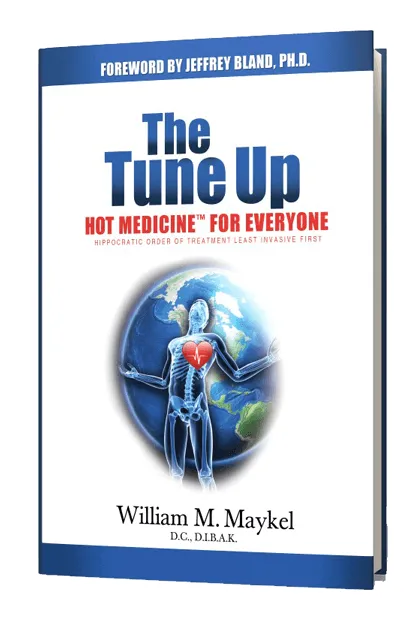Our Philosophy of Practice
a Chronological Journey
My practice involves giving the patient as much in depth structural care, related lifestyle education, and supportive tools as possible on a visit. It also includes the utilization of clinical nutritional support to speed up the healing process as is indicated. This represents a break from the traditional (usual and customary – archaic?) doling out of health services and information in dribs and drabs at the patient’s expense of time and suffering to a more modern patient-centered one of efficient time management, and problem resolution via comprehensive treatment and enhanced patient education/involvement.
My clinical experience has shown that the majority of people are deficient in the key mineral magnesium and in the essential omega 3 fatty acid-eicosapentaenoic (EPA). This concurs with the findings of leading nutritionally oriented doctors like Dr. Barry Sears (in a personal conversation he agreed that 90% of people have insufficient magnesium) and Dr. Steve Sinatra, cardiologist – who wrote that 70% of people in America are deficient in magnesium. A recent survey of the US population found 99.9% of people to be deficient in EPA.
The mineral magnesium has been out of the top soils in industrialized countries for the last 80 years and we have only replaced nitrogen, potassium and phosphorous (NPK fertilizers). Magnesium is necessary for 300 enzyme systems (which is 80% of the total) in the human body and is essential for the production of ATP-the body’s main energy source and nerve signal transmission. It also acts as a muscle relaxer. Calcium on the other hand acts as a muscle contractor and in the United States today we have far too much calcium – read Walter Willett’s new book “Eat, Drink and be Healthy.” He is the head of Harvard Medical School’s Department of Nutrition.
Low magnesium levels in our diet is just half of the problem. Magnesium is depleted by stress, sweat, caffeinated beverages, carbonated beverages, alcoholic beverages, phosphorous containing soft drinks, pollution, prescription drugs and most multivitamin mineral supplements and calcium supplements because they are skewed 2 to 1 calcium to magnesium. So basically everything is working against your body’s ability to maintain an adequate magnesium reservoir. This is especially true when you consider that magnesium absorption is adversely affected by dysinsulinism. This refers to the skyrocketing blood sugars of a society living on stress, caffeine, refined carbohydrates, sugar and missed meals.
In my opinion the magnesium problem is linked to 2 of the leading causes of death in the United States today. 1) Death from heart disease – 1 million people die annually, and half of those people’s first symptom of heart disease is instant death. Twenty percent of these people have absolutely nothing wrong with their vascular tree. They die from an acute contraction of the arteries in their heart (too much calcium contracting and no magnesium relaxing their arteries; 2) the leading cause of death in women 65 years and older – which are complications of a fractured hip. Magnesium is necessary for flexibility in the bony skeleton and directs the body’s placement of calcium into bone.
The US Government tells us that on a daily average a man gets 300mg and a woman gets 250mg of magnesium from their diets. They also tell us that we need 500 to 1,000mg per day. Remember all forms of increased stress increase the body’s need for more magnesium. So, I recommend that all of my patients use 400 to 600mg of magnesium (either citrate or glycinate) in addition to their multivitamin mineral on a daily basis.
When a person runs out of magnesium they may experience both fatigue and muscle cramps at rest, fatigue (both physically and mentally) and musculoskeletal instability, which leads to chronic pain patterns. Magnesium is responsible for the generation of ATP in the Krebs cycle, which is the only fuel the brain can use. Do you think this could be related to the fact that fatigue is the number one reason people go to their doctors?
What I have found is that insufficient magnesium causes peoples’ jaw muscles go into spasm when they chew food. Over time this causes a jamming of the sutures between the 22 moveable bones in their skull creating a subsequent weakening of their entire ligamentous system. This occurs because the cranium no longer moves to massage the brain and thus the neuroendocrine axis (the pineal, pituitary, hypothalumus-which is the highest point in the nervous system where you deal with stress) is dampened. Kinesiologically speaking once this happens, the muscles related to the thyroid and adrenals are usually found to be weak. Additionally when a person’s head is covered with a towel (reproducing being in the dark) it will weaken a strong muscle. This is suggestive of a lack of normal pineal function. The pineal gland drives the adrenal glands, one of whose functions is to maintain strong ligaments. Ligaments are supposed to be like stainless steel bands to keep a joint within a normal range of motion. When the cranial motion is inhibited and thus the signal from the pineal to the adrenals is dampened the ligaments become more like gum rubber leading to joint instability.
What I have discovered is that if you take a strong muscle and then stretch it and retest it and that if it now becomes weak, that this is related to a low normal or slightly below normal levels of magnesium in the red blood cells and in the buccal mucosa. So if you stretch muscles and they weaken throughout the body you can rest assured that the person has insufficient amounts of magnesium. So what occurs structurally is a double whammy. The body loses the muscle protection of its joints while at the same time the ligaments maintaining the integrity of the joints are diminished in strength.
I tell patients that their body is their vehicle to get them through space. Their feet are their tires and their pelvis is their front end. Each foot has 26 bones that make up three arches. Once a person has lower magnesium levels they develop whole body misalignment patterns. Their feet (tarsel tunnels) become strained creating a rotation of the tibias and subsequently pelvic unleveling (bilateral sacro-iliac joint sprain/strain). I tell them that they have two flat tires and their front end is misaligned.
Every person has 100 trillion cells in their body. Each cell has a double fat membrane around it and if you took all of the fat out of your 100 trillion cell membranes and put it in a 1 molecule thick oil slick, each human body has a 10 square mile area of fat. Dr. Sears refers to this as the body’s biological internet. There are two “essential” fatty acids (EFA’s) – essential because they need to be eaten daily and stored in this biological internet. The two EFA’s are Omega 3’s and Omega 6’s. These two EFA’s make a group of strong hormones known as eicosanoids. These were the first hormones developed by living organisms more than 500 million years ago, they can be considered super hormones because they control the actions of other hormones. The Nobel Prize in medicine in 1982 was awarded for the discovery of how eiconsanoids play a role in human disease. To date they have identified over 100 eicosanoids, they can either be pro or anti-inflammatory. They are hormones that maintain the information fidelity of your biological internet which means they hold the key to health and longevity.
The Omega 6’s come from vegetable oils, dairy and meat. They end up primarily as a arachadonic acid which is a precursor to the proinflammatory eicosanoids. The Omega 3’s come from algae that got concentrated in fish. They are precursors for anti-inflammatory eicosanoids. EPA (eicospentaenoic acid) is the chief omega 3 fatty acid. ALA (alphalinolenic acid) found in flax seed oil, walnuts and soy may be elongated to become EPA, but the conversion process is hampered by heavy metals, trans fats and nutritional imbalances. Thus the conversion is iffy at best. Scientifically speaking the ratio of 6 to 3’s should be 1 to 1. Unfortunately we are skewed as a nation towards high 6 and almost non-existent 3. The following diseases are associated with this imbalance-depression, ADHD, heart disease, high blood pressure, Type 2 diabetes, cancers, autoimmune and inflammatory diseases.








